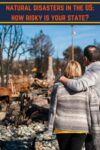One of the first steps in preparing for disasters is figuring out which disasters your area is most likely.
Americans need to worry about natural disasters, including hurricanes, floods, tornadoes, severe storms, wildfires, winter storms and frost, drought, earthquakes, and volcanoes.
This guide goes over key disaster statistics for the United States, including the safest and worst states for natural disasters, which natural disasters cause the most damage and resources for preparing for disasters.
Table Of Contents
Bottom Line Upfront
The states with the highest risk of natural disasters are:
- California
- Texas
- Oklahoma
- Washington
- Mississippi
The states with the least risk are:
- Rhode Island
- Delaware
- Hawaii
- Vermont
- Maine
Natural Disasters Interactive Map
Very Low Risk
Low Risk
Medium Risk
High Risk
Very High Risk
Most Common Natural Disasters in the USA
From 2000 to December 2022, there have been approximately 2,800 Disaster Declarations in the United States. Of these, wildfires were the most common natural disaster, followed by severe storms (tornado, hailstorm, and derecho storms) and floods.
Most Common Disaster Declarations Since 2000
- Fire: 1,549 events
- Severe Storm: 1,026 events
- Flood: 856 events
- Tropical Storms: 528 events
- Snowstorms: 169
What is a Disaster Declaration? A Disaster Declaration is a formal statement by a local or state official (such as a mayor or governor) that the emergency is beyond their response capabilities. It allows the local government to seek help from the federal government. Not all natural disasters result in a Disaster Declaration.
Most Common Natural Disasters By Region
The most common type of natural disaster varies drastically by region. In the Northeast and Midwest, severe storms are most common. In the South, tropical storms prevail. In the West and Southwest, wildfires are most common.
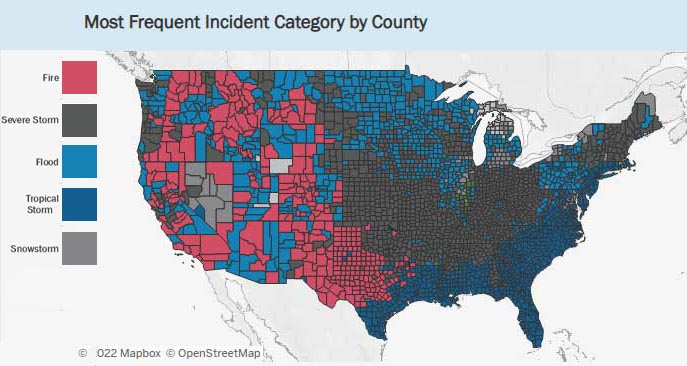
Which Types of Natural Disasters Cause the Most Damage in the United States?
The National Oceanic and Atmospheric Administration (NOAA) keeps track of natural disasters which caused more than $1 billion in damages, adjusted for inflation. Since 2000, there have been over 2,100 billion-dollar events in the United States.
Of these billion-dollar disasters, hurricanes by far cause the most damage. Since 2000, hurricanes have caused $1,034 billion in damages, which averages $27.2 billion per event.
Natural Disasters which Caused More than $1 Billion in Damages (Since 2000)
| Type | Frequency | Total Cost (Billions) |
|---|---|---|
| Hurricanes/Tropical Cyclones | 254 | $1,034 |
| Severe Storms | 1,146 | $325.7 |
| Drought | 338 | $175 |
| Wildfires | 171 | $114.1 |
| Flooding | 115 | $91.3 |
| Winter Storms | 106 | $41.3 |
| Freeze Events | 28 | $6.1 |
Are Natural Disasters Increasing in the USA?
Yes, there has been a considerable increase in major natural disasters in the United States. In the 1980s, there was an average of just 3 billion-dollar natural disaster events per year. By the 2000s, this number had increased to nearly 13 major natural disasters per year. In 2020 and 2021 alone, there were 42 major natural disasters.
Number of Major Natural Disasters in the USA by Decade:
- 1980-1989: 31 events
- 1990-1999: 55 events
- 2000-2009: 67 events
- 2010-2019: 128 event s
- 2020 and 2021: 42 events
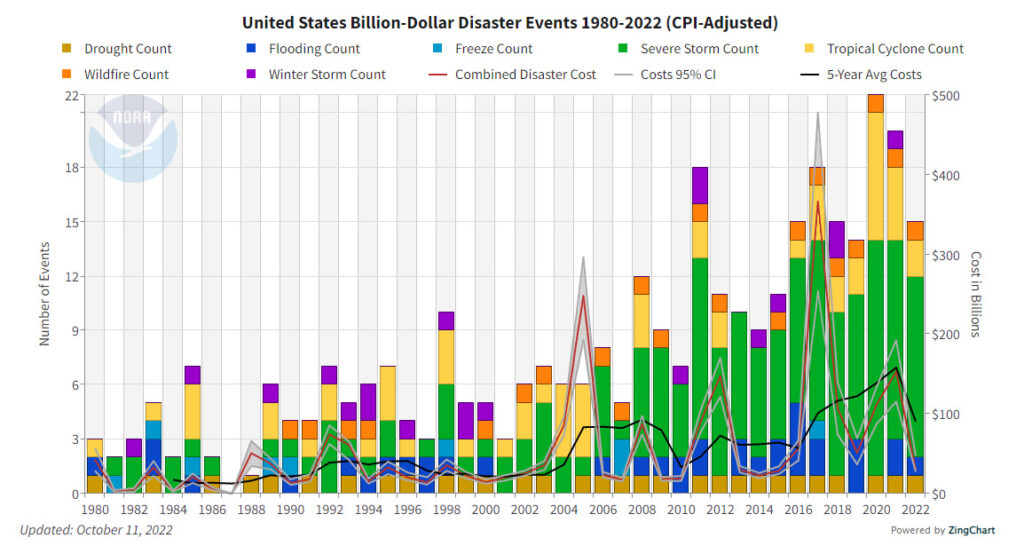
Part of the reason major natural disasters are increasing is simply that there are more people. More people means more property, which increases the total monetary damage of a natural disaster.
However, when we look at the frequency of natural disaster declarations, we can see that these are increasing too.
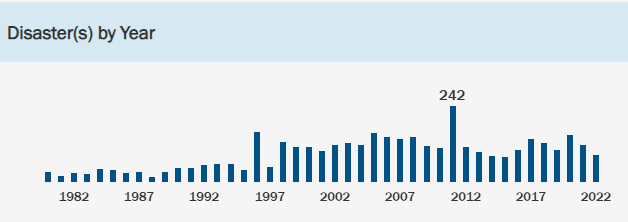
The good news?
While the frequency of natural disasters is occurring, the number of deaths per event is decreasing.
This is because of better warning systems, planning, and infrastructure. In the 1980s, there was an average of nearly 96 deaths per major natural disaster. By the 2010s, this number went down to 41 deaths per event. As of 2020, the number of fatalities has gotten even lower.
- 1980s: 31 events and 2,970 deaths
- 1990s: 55 events and 3,062 deaths
- 2000s: 67 events and 3,102 deaths
- 2010s: 128 events and 5,227 deaths
- 2020: 22 events and 262 deaths
- 2021: 20 events and 724 deaths
Natural Disaster Risk Ranking by State
The states with the highest risk of natural disasters are Louisiana, Colorado, Tennessee, Illinois, and Kentucky. The states with the least risk are Maine, Vermont, Alaska, Connecticut, and North Dakota.
How is Natural Disaster Risk Calculated?
There are two main ways to calculate how at-risk a state is for natural disasters.
The first method examines how many $1 billion events have occurred in the state. This method shows how likely a very destructive event is to occur. However, it skews the ranking towards states with bigger populations in urban areas: even a minor disaster can cause massive economic damage in these areas.
The other method looks at how many Disaster Declarations where declared in the state. For example, Hawaii hasn’t had a single natural disaster since 2000, which caused more than $1 billion in damages, but the state still had 61 Disaster Declarations.
This ranking doesn’t always give a clear risk assessment because politics are involved in the Disaster Declaration process.
Also, states with large budgets and good disaster planning may be less likely to make an official Disaster Declaration, even when the damages are very bad. For example, Minnesota had 35 events that caused $1 billion in damages but only declared a disaster 7 times.
The following natural disaster rankings were made by tallying both the number of Disaster Declarations and $1 billion events since 2000.
States with the Most Natural Disasters (Since 2000):
- Louisiana
- Colorado
- Tennessee
- Illinois
- Kentucky
- Arkansas
- Texas
- Iowa
- Pennsylvania
- Montana
States with the Fewest Natural Disasters (Since 2000):
- Maine
- Vermont
- Alaska
- Connecticut
- North Dakota
- Delaware
- Massachusetts
- Idaho
- South Dakota
- Rhode Island
Worst Recent Natural Disasters in the United States
When you look at the worst natural disasters in the United States since 2000, hurricanes top the list.
Causing $186.3 billion in damage, Hurricane Katrina was the most costly natural disaster.
If we look at the death toll, Hurricane Maria was the worst natural disaster. It caused 2,981 deaths. Hurricanes were more costly and deadly than any other natural disaster in recent history.
Worst Natural Disasters in the USA by Cost, since 2000
- Hurricane Katrina (2005): $186.3 billion
- Hurricane Harvey (2017): $148.8 billion
- Hurricane Maria (2017): $107.1 billion
- Hurricane Ida (2021): $78.7 billion
- Hurricane Irma (2017): $59.5 billion
- Hurricane Ike (2008): $40.2 billion
- US Drought/Heat Wave (2012): $38.7 billion
- Hurricane Ivan 2004: $31.6billion
- Hurricane Michael (2018): $29 billion
- Hurricane Wilma (2005): $27.9 billion
Worst Natural Disasters in the USA by Deaths since 2000
- Hurricane Maria (2017): 2,981 deaths
- Hurricane Katrina (2015): 1,833 deaths
- Southeast/Ohio Valley/Midwest Tornadoes (2011): 321
- NW/Central/Eastern Winter Storm and Cold Wave (2021): 262 deaths
- Western Drought and Heat Wave (2021): 229 deaths
- Midwest/Southeast Tornadoes (2011): 177 deaths
- Hurricane Sandy (2012): 159 deaths
- Western/Central/SE Drought and Heat Wave (2000): 140 deaths
- Hurricane Ian (2022): 131 deaths
- US Drought and Heat Wave (2012): 123 deaths
Which Natural Disasters Occur in the USA?
All types of natural disasters occur in the United States. These include Severe storms, drought, hurricanes, wildfires, floods, winter storms, freeze events, volcanic eruptions, and earthquakes.
Below we’ll go over each type of natural disaster and where it is most likely to occur in the United States.
Severe Storms
Severe storms are the most common type of major natural disaster in the United States. Since 2000, there have been 139 major severe storms in the United States, causing $325.7 billion in damages and 1,358 deaths. However, not all states are at risk.
States More At Risk of Major Severe Storms:
- Texas
- Illinois
- Missouri
- Oklahoma
- Indiana
States Least At Risk for Major Severe Storms:
- Connecticut
- Idaho
- Nevada
- Hawaii
- Alaska
Read more:
Hurricanes/Tropical Storms
Hurricanes don’t occur as frequently as severe storms. However, when they do occur, they cause massive amounts of damage. The 40 severe hurricanes which occurred since 2000 caused $1,034 billion in damages (an average of $27.2 billion per event) and resulted in 6,356 deaths.
States More At Risk of Major Severe Hurricanes:
- Florida
- North Carolina
- Georgia
- Louisiana
- Alabama
States Least At Risk of Major Severe Hurricanes:
Many states have never seen a major hurricane or tropical cyclone. These include:
- Midwest States: Only Missouri, Ohio, and Illinois have had major tropical cyclones since 2000
- West States: New Mexico is the only Western State to have had a major tropical cyclone.
- Alaska
- Hawaii
- Maine
Read more:
Drought
Drought has become an increasingly common natural disaster in many parts of the United States. Since 2000, there have been 19 major droughts in the United States, costing a total of $175 billion.
While droughts haven’t caused deaths, the heat waves associated with them have caused 852 deaths.
States More At Risk of Major Drought:
- California
- Oregon
- New Mexico
- Arizona
- Colorado
- Kansas
States Least At Risk for Major Drought:
- Hawaii
- Alaska
- New Hampshire
- Rhode Island
- Massachusetts
- Connecticut
- Vermont
- Maine
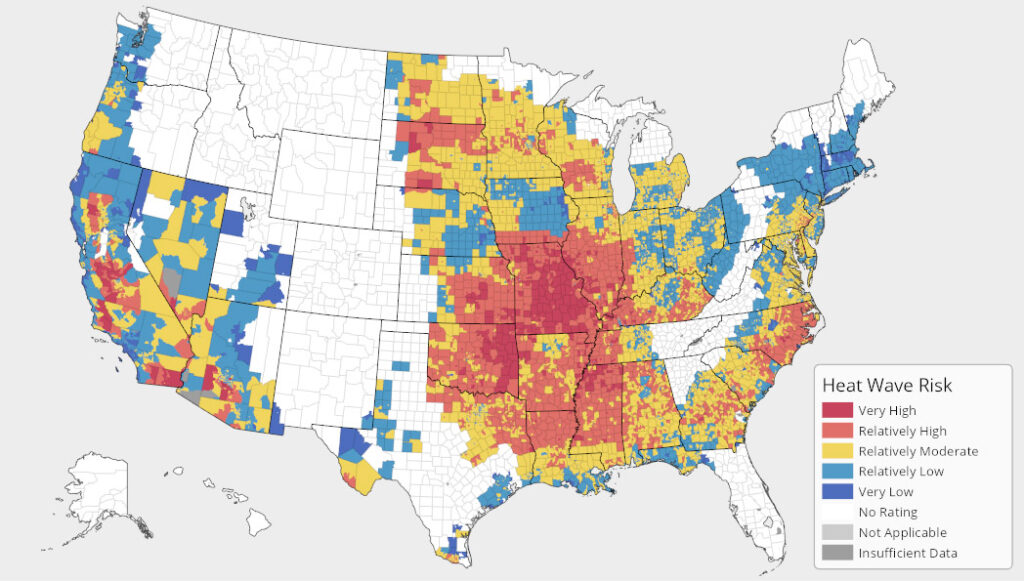
Also read:
Wildfires
Since 2000, there have been 17 major wildfires in the United States. They caused $114.1 billion in damages ($7.1 billion per event) and 389 deaths.
Almost all Western States are at risk of wildfires, along with much of the Midwest and South. With global warming, wildfires are only expected to increase.
States Most At Risk of Major Wildfires
- California
- Idaho
- Oregon
- Washington
- Montana
- Arizona
States Least At Risk of Major Wildfires
- Hawaii
- Northeast States
- Kentucky
- Arkansas
- Maryland
- Virginia
- West Virginia
- South Carolina
- Louisiana
- Wisconsin
- Kansas
- Illinois
- Missouri
- Ohio
- Indiana
- Michigan
- Iowa
Read more:
Floods
There have been 25 major floods in the United States since 2000, costing $91.3 billion and claiming 318 lives. Remember that this number is only for floods that caused more than $1 billion in damage. Smaller floods occur much more frequently.
On average, the United States experiences an urban flood event once every 2-3 days. The damage from these more minor floods adds up quickly: 2/3 of all costs from natural disasters are from floods.
Because of climate change, approximately 14.6 million properties in the USA are at risk of 100-year floods. This includes many homes inland that can still experience devastating floods due to river flooding and flash flooding from heavy rains.
Almost nowhere is safe: 99% of US counties are impacted by flooding.
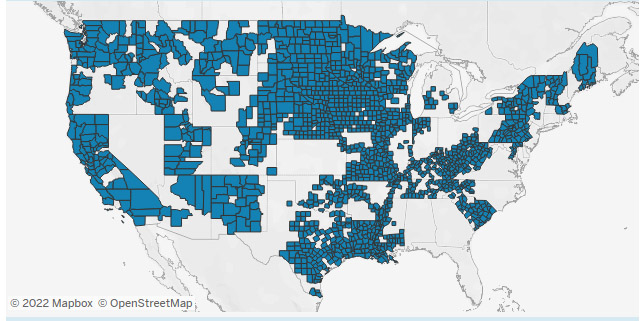
States Most At Risk of Major Floods:
- Missouri
- Louisiana
- Texas
- Arkansas
- Oklahoma
- Indiana
- Illinois
- Iowa
- Kansas
States Least At Risk for Major Floods:
Most Western States have a lower risk of flooding. However, the tradeoff is that these are the states where drought and wildfires are a concern.
Read more:
Winter Storms and Freeze Events
Since 2000, there have been just 11 major winter storm and freeze events in the United States. Interestingly, places known for cold weather (such as Alaska, North Dakota, and Minnesota) had no severe winter storm or freeze events.
By contrast, the USA’s South Atlantic region– known for its mild weather – was more likely to have devastating winter storms or freeze events.
This is because the region is less likely to be prepared for severe winter weather. Their infrastructure isn’t designed to handle extreme cold, so it takes a large toll when an event does happen.
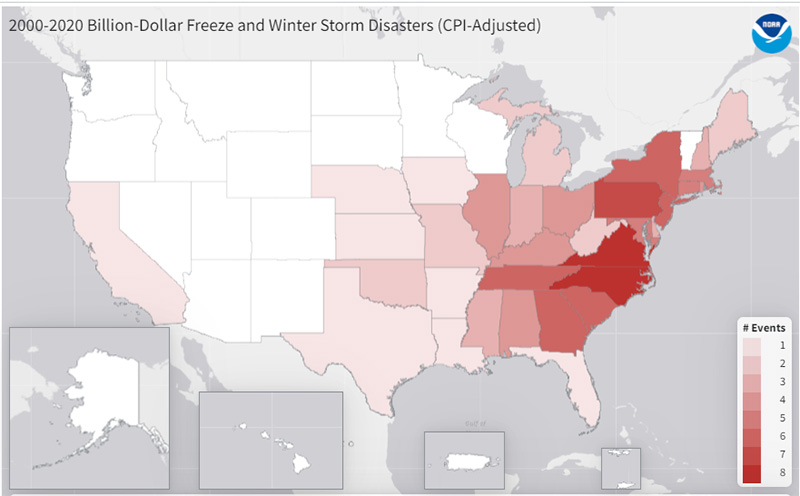
Also Read:
Earthquakes
High-magnitude earthquakes do not frequently occur in the United States. When they do occur, they are usually in sparsely populated areas and do not cause much damage. There have only been 22 deaths from earthquakes since 2000.
However, this does not mean Americans don’t have to worry about earthquakes. Many large cities in the USA are on significant fault lines. It would be devastating if a high-magnitude quake hit one of these areas.
For example, if a magnitude 8 earthquake occurred on the San Andreas Fault (known as the “Big One”), thousands of people would be killed by debris and fires. The earthquake could also destroy infrastructure for power, water, gas, and sewage, leaving millions without access to vital utilities.
Remember that nearly half of the nation’s food supply is grown in California. The LA port also handles a considerable percentage of the nation’s cargo shipments. So, supply chain disruptions from the earthquake would also affect the rest of the USA.
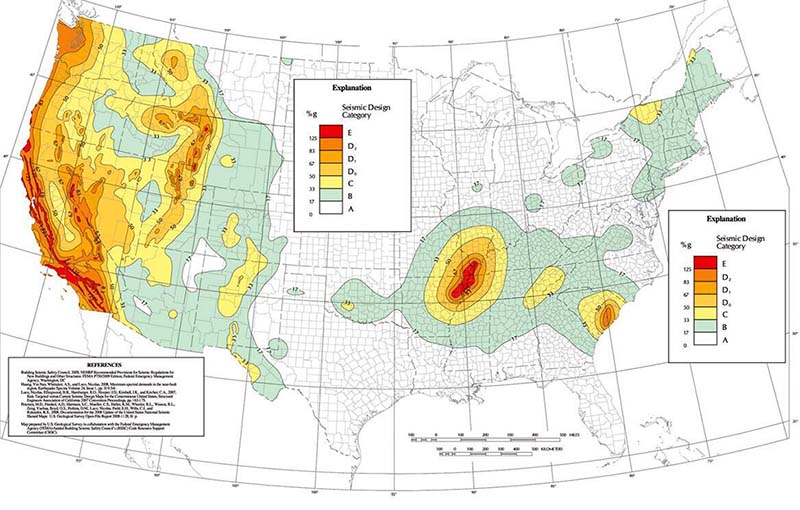
Read more:
Volcano
Volcanic eruptions occur very rarely in the United States. Hawaii is the only state which has declared a disaster due to volcanoes. Only one person has died from a volcano in Hawaii this century.
However, like earthquakes, that doesn’t mean Americans shouldn’t worry about volcanoes.
If the supervolcano under Yellowstone were to erupt, it would be catastrophic. The eruption could cause ash to spew thousands of miles across the USA. People in the immediate area would be buried under the ash. If they didn’t die immediately, they would suffer from respiratory problems. The ash would blanket land and cause crop failure, which could cause a famine.
Also Read:
https://www.ncei.noaa.gov/access/billions/
https://www.fema.gov/disaster/how-declared
https://www.sanandreasfault.org/BigOne.html
https://www.cnbc.com/2017/09/27/major-quake-disaster-in-california-could-cause-300-billion-in-losses.html
https://www.nytimes.com/interactive/2020/06/29/climate/hidden-flood-risk-maps.html
https://www.theguardian.com/us-news/2022/aug/11/america-summer-floods-rainfall-climate-crisis
https://www.usgs.gov/programs/earthquake-hazards/lists-maps-and-statistics
https://www.usgs.gov/programs/earthquake-hazards/information-region
https://www.fema.gov/sites/default/files/2020-07/fema_hazard_maps_western-map_graphic.jpg
https://www.fema.gov/sites/default/files/2020-07/fema_hazard_maps_eastern-map_graphic.jpg
https://hazards.fema.gov/nri/heat-wave
https://www.reuters.com/business/environment/hawaiis-mauna-loa-volcano-erupts-2022-11-29/
https://www.fema.gov/pdf/rrr/dec_proc.pdf
https://www.fema.gov/data-visualization/disaster-declarations-states-and-counties
https://www.ncei.noaa.gov/access/billions/events/WY/2000-2022?disasters[]=all-disasters
https://www.worlddata.info/america/usa/earthquakes.php
